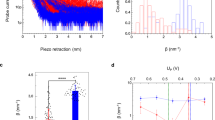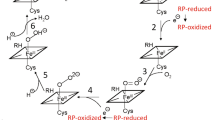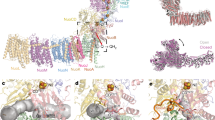Abstract
The structure of pseudoazurin from Thiosphaera pantotropha has been determined and compared to structures of both soluble and membrane-bound periplasmic redox proteins. The results show a matching set of unipolar, but promiscuous, docking motifs based on a positive hydrophobic surface patch on the electron shuttle proteins pseudoazurin and cytochrome c550 and a negative hydrophobic patch on the surface of their known redox partners. The observed electrostatic handedness is argued to be associated with the charge-asymmetry of the membrane-bound components of the redox chain due to von Heijne's ‘positives-inside’ principle. We propose a ‘positives-in-between’ rule for electron shuttle proteins, and expect a negative hydrophobic patch to be present on both the highest and lowest redox potential species in a series of electron carriers.
This is a preview of subscription content, access via your institution
Access options
Subscribe to this journal
Receive 12 print issues and online access
$189.00 per year
only $15.75 per issue
Buy this article
- Purchase on Springer Link
- Instant access to full article PDF
Prices may be subject to local taxes which are calculated during checkout
Similar content being viewed by others
References
Adman, E.T. Copper Protein Structures. in Advances in Protein Chemistry (eds Anfinsen, C.B., Edsall, J.T., Richards, F.M. & Eisenberg, D.S.) 145–197 (Academic Press; 1991).
Adman, E.T. Structure and function of copper-containing proteins. Curr. Opin. struct. Biol. 1, 895–904 (1991).
Malmström, B.G. Rack-induced bonding in blue-copper proteins. Eur. J. Biochem. 223, 711–718 (1994).
Berks, B.C., Baratta, D., Richardson, D.J. & Ferguson, S.J. Purification and characterization of a nitrous oxide reductase from Thiosphaera pantotropha. Eur. J. Biochem. 212, 467–476 (1993).
Moir, J.W.B., Baratta, D., Richardson, D.J. & Ferguson, S.J. The purification of a cd1-type nitrite reductase from, and the absence of a copper-type nitrite reductase from, the aerobic denitrifier Thiosphaera pantotropha -the role of pseudoazurin as an electron-donor. Eur. J. Biochem. 212, 377–385 (1993).
Moir, J.W.B. & Ferguson, S.J., Properties of Paracoccus denitrificans mutant deleted in cytochrome c550 indicate that a copper protein can substitute for this cytochrome in electron transport to nitrite, nitric oxide and nitrous oxide. Microbiology 140, 389–397 (1994).
Sjölin, L. et al. Structure of Pseudomonas aeruginosa zinc-azurin mutant Asn47Asp at 2.4 Å resolution. Acta crystallogr. D49, 449–457 (1993).
Chan, C. et al. The complete amino acid sequence confirms the presence of pseudoazurin in Thiosphaera pantotropha. Biochem. J. 308 585–590 (1995).
Lee, B. & Richards, F. The interpretation of protein structure: estimation of static accessibility. J. molec. Biol. 55, 379–400 (1971).
Siegelman, M.H., Rasched, I.R., Kunert, K.J., Kroneck, P. & Böger, P. Plastocyanin: possible significance of quaternary structure. Eur. J. Biochem. 64, 131–140 (1976).
Fülöp, V., Moir, B., Ferguson, S.J. & Hajdu, J. The anatomy of a bifunctional enzyme: structural basis for reduction of oxygen to water and synthesis of nitric oxide by cytochrome cd1 . Cell 81, 369–37 (1995).
Parr, S.R., Barber, D., Greenwood, C. & Brunori, M. The electron transfer reaction between azurin and the cytochrome c oxidase from Pseudomonas aeruginosa. Biochem. J. 167, 447–455 (1977).
Yamanaka, T. & Okunuki, K. Crystalline pseudomonas cytochrome oxidase. Biochim. biophys. Acta 67, 379–393 (1963).
Ikeda, O. & Sakurai, T. Electron transfer reaction of stellacyanin at a bare glassy carbon electrode. Eur. J. Biochem. 219, 813–819 (1994).
McLendon, G. Control of biological electron-transport via molecular recognition and binding—the velcro model. Structure and Bonding (eds M. J. Clarke et al.) 75, 159–174 (Springer, Berlin; 1991).
Jeng, M., Englander, S.W., Pardue, K., Rogalskyj, J.S. & McLendon, G. Structural dynamics in an electron-transfer complex. Nature struct. Biol. 1, 234–238 (1994).
Gray, K.A., Davidson, V.L. & Knaff, D.B. Complex formation between methylamine dehydrogenase and amicyanin from Paracoccus denitrif icans. J. biol. Chem. 263, 13987–13990 (1988).
Kukimoto, M. et al. Identification of interaction site of pseudoazurin with its redox partner, copper-containing nitrite reductase from Alcaligenes faecalis S-6. Prot. Engng. 8, 153–158 (1995).
Kamp, M.v.d. et al. Involvement of the hydrophobic patch of azurin in the electron-transfer reactions with cytochrome c551 and nitrite reductase. Eur. J. Biochem. 194, 109–118 (1995).
Nar, H., Messerschmidt, A., Huber, R., Kamp, M.v.d. & Canters, G.W. X-ray crystal structure of the two site-specific mutants His35Gln and His35Leu of azurin from Pseudomonas aeruginosa. J. molec. Biol. 218, 427–447 (1991).
Durley, R., Chen, L., Lim, L.W., Mathews, F.S. & Davidson, V.L. Crystal structure analysis of amicyanin and apoamicyanin from Paracoccus denitrificans at 2.0 Å and 1.8 Å resolution. Protein. Sci. 2, 739–752 (1993).
Salamme, F.R. An hypothetical structure for an intermolecular electron transfer complex of cytochromes c and b5 . J. molec. Biol. 102, 563–568 (1976).
van Spanning, R.J.M. et al. Mutagenesis of the gene encoding cytochrome c550 of Paracoccus denitrif icans and analysis of the resultant physiological effects. J. Bacterial. 172, 986–996 (1990).
Samyn, B., Berks, B.C., Page, M.D., Ferguson, S.J. & van Beeumen, J. Characterisation and amino acid sequence of cytochrome c550 from Thiosphaera pantotropha. Eur. J. Biochem. 219, 585–594 (1994).
Timkovich, R. & Dickerson, R.E. The Structure of Paracoccus denitrificans cytochrome c550 . J. biol. Chem. 251, 4033–4046 (1976).
Benning, M.M., Meyer, T.E. & Holden, H.M. X-ray structure of the cytochrome c2 isolated from Paracoccus denitrificans refined to 1.7 Å resolution. Arch. biochem. Biophys. 310, 460–466 (1994).
Matsuura, Y., Takano, T. & Dickerson, R.E. Structure of cytochrome c551 from Pseudomonas aeruginosa refined at 1.6Å resolution and comparison of the two redox forms. J. molec. Biol. 156, 389–409 (1982).
Lam, Y. & Nicholas, D.J D. A nitrite reductase with cytochrome oxidase activity from Paracoccus denitrificans. Biochim. biophys. Acta 180, 459–472 (1969).
Wharton, D.C., Gudat, J.C. & Gibson, Q.H. Cytochrome oxidase from Pseudomonas aeruginosa : II Reaction with Copper Protein. Biochim. biophys. Acta 292, 611–620 (1973).
Silvestrini, M.C., Tordi, M.G., Colosimo, A., Antonini, E. & Brunori, M. The kinetics of electron transfer between Pseudomonas aeruginosa cytochrome c551 and its oxidase. Biochem. J. 203, 445–451 (1982).
Chen, L. et al. Crystal structure of an electron-transfer complex between methylamine dehydrogenase and amicyanin. Biochemistry 31, 4959–4964 (1992).
Chen, L., Durley, R.C.E., Mathews, F.S. & Davidson, V.L. Structure of an electron transfer complex: methylamine dehydrogenase, amicyanin, and cytochrome c551 . Science 264, 86–90 (1994).
Von Heijne, G. Membrane-proteins - from sequence to structure. A. Rev. Biophys. biomol. Struct 23, 167–192 (1994).
Allen, J.P., Feher, G., Yeates, T.O., Komiya, H. & Rees, D.C. Structure of the reaction center from Rhodobacter-sphaeroides r-26 - the protein subunits. Proc. natn. Acad. Sci. U.S.A. 84, 6162–6166 (1987).
Iwata, S., Ostermeier, C., Ludwig, B. & Michel, H. Structure at 2.8 Å resolution of cytochrome oxidase from Paracoccus denitrificans. Nature 376, 660–669 (1995).
Witt, H., Zickermann, V. & Ludwig, B. Site-directed mutagenesis of cytochrome c oxidase reveals two acidic residues involved in the binding of cytochrome c. Biochim. biophys. Acta 1230, 74–76 (1995).
Rees, D.C. Electrostatic influence on energetics of electron transfer reactions. Proc. natn. Acad. Sci. U.S.A. 82, 3082–3085 (1995).
Poulos, T.L., Sheriff, S. & Howard, A.J. Co-crystals of yeast cytochrome c peroxidase and horse heart cytochrome c. J. biol. Chem. 262, 13881–13884 (1987).
Poulos, T.L. & Kraut, J. A hypothetical model of the cytochrome c peroxidase cytochrome c electron transfer complex. J. biol. Chem. 255, 10322–10330 (1980).
Pelletier, H. & Kraut, J. Crystal structure of a complex between electron transfer partners, cytochrome c peroxidase and cytochrome c. Science 258, 1748–1755 (1992).
Galzi, J.L. & Changeux, J.P. Neurotransmitter-gated ion channels as unconventional allosteric proteins. Curr.Opi. struct. Biol. 4, 554–565 (1994).
Fourme, R., Ducruix, A., Ries-Kaut, M. & Capelle, B. The perfection of protein crystals probed by direct recording of Bragg reflection profiles with a quasi-planar X-ray wave. J. synchrotron Rad. 2, 136–142 (1995).
Otwinowski, Z. Oscillation data reduction program. in Data Collection and Processing (eds Sawyer, L, Isaacs, N. W. & Bailey S.) 55–62 DL/SCI/R34 (Daresbury Laboratory, Warrington 1993).
CCP4. The CCP4 Suite: programs for protein crystallography. Acta crystallogr. D50, 760–763 (1994).
Rossmann, M.G. & Blow, D.M. The detection of sub-units within the crystallographic asymmetric unit. Acta crystallogr. 15, 24–31 (1962).
Matthews, B.W. Solvent content of protein crystals. J. molec. Biol. 33, 491–497 (1968).
Petratos, K., Dauter, Z. & Wilson, K.S. Refinement of the structure of Pseudoazurin from Alcaligenes faecalis S-6 at 1.55Å Resolution. Acta crystallogr. B44, 628–636 (1988).
Navaza, J. AMoRe: an automated package for molecular replacement. Acta crystallogr. A50, 157–163 (1994).
Brünger, A.T., Kuriyan, J. & Karplus, M., R-factor refinement by molecular dynamics. Science, 235, 458–460 (1987).
Brünger, A.T., Krutowski, A. & Erickson, J.W. Slow-cooling protocols for crystallographic refinement by simulated annealing. Acta crystallogr., A46, 585–593 (1990).
Jones, T.A., Bergdoll, M. & Kjeldgaard, M. O: a macromolecule modelling environment. In Crystallographic and Modelling Methods in Molecular Design. (eds Bugg, C. & Ealick, S.) 189–199 (Springer, New York. 1990).
Jones, T.A., Zou, J.Y., Cowan, S.W. & Kjeldgaard, M. Improved methods for building protein models in electron density maps and the location of errors in these models. Acta crystallogr. A47, 110–119 (1991).
Brünger, A.T. The free R value: a novel statistical quantity for assessing the accuracy of crystal structures. Nature 355, 472–474 (1992).
Read, R.J., Fourier coefficients for maps using phases from partial structures with errors. Acta crystallogr. A42, 140–149 (1986).
Kraulis, P.J. MOLSCRIPT: a program to produce both detailed and schematic plots of protein structures. J. appl. Crystallogr. 24, 946–950 (1991).
Merritt, E.A. & Murphy, M.E.P., Raster 3D Version 2.0Å program for photorealistic molecular graphics. Acta crystallogr. D50, 869–873 (1994).
Author information
Authors and Affiliations
Rights and permissions
About this article
Cite this article
Williams, P., Fülöp, V., Leung, YC. et al. Pseudospecific docking surfaces on electron transfer proteins as illustrated by pseudoazurin, cytochrome c550 and cytochrome cd1 nitrite reductase. Nat Struct Mol Biol 2, 975–982 (1995). https://doi.org/10.1038/nsb1195-975
Received:
Accepted:
Issue Date:
DOI: https://doi.org/10.1038/nsb1195-975
This article is cited by
-
Pseudoazurin from Sinorhizobium meliloti as an electron donor to copper-containing nitrite reductase: influence of the redox partner on the reduction potentials of the enzyme copper centers
JBIC Journal of Biological Inorganic Chemistry (2014)
-
Structures of protein–protein complexes involved in electron transfer
Nature (2013)
-
The electron transfer complex between nitrous oxide reductase and its electron donors
JBIC Journal of Biological Inorganic Chemistry (2011)
-
Structural basis of inter-protein electron transfer for nitrite reduction in denitrification
Nature (2009)
-
Mediated catalysis of Paracoccus pantotrophus cytochrome c peroxidase by P. pantotrophus pseudoazurin: kinetics of intermolecular electron transfer
JBIC Journal of Biological Inorganic Chemistry (2007)



